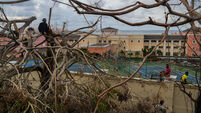Toxic red sludge flood an ‘ecological disaster’
The toll rose to four dead, six missing and at least 120 people injured after a reservoir failed on Monday at the Ajkai Timfoldgyar plant in Ajka, a town 160km southwest of the capital Budapest.
Several hundred tonnes of plaster were being poured into the Marcal River to bind the toxic sludge and prevent it from flowing on, the National Disaster Management Directorate said.














